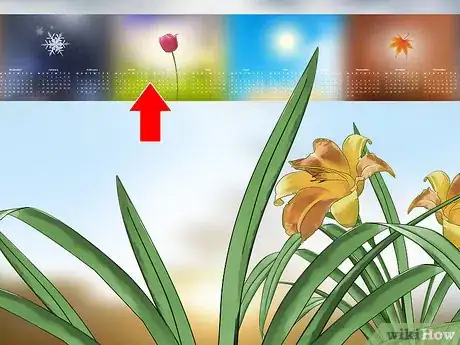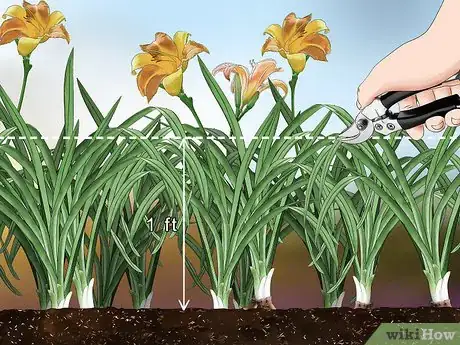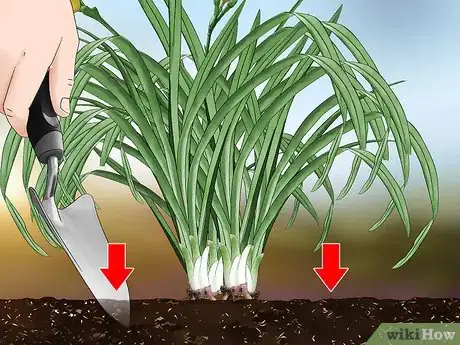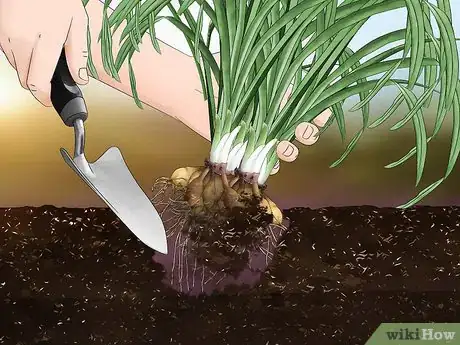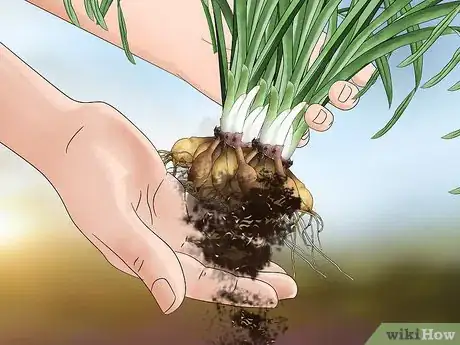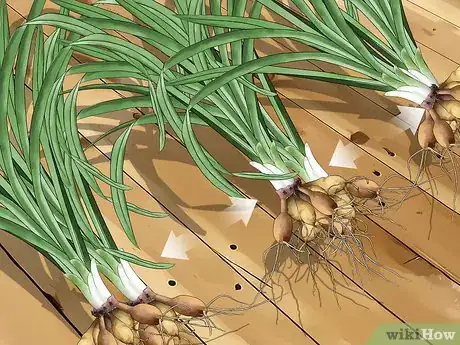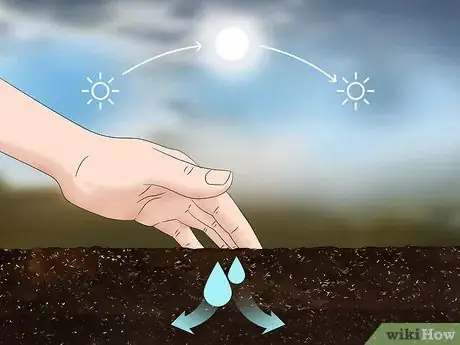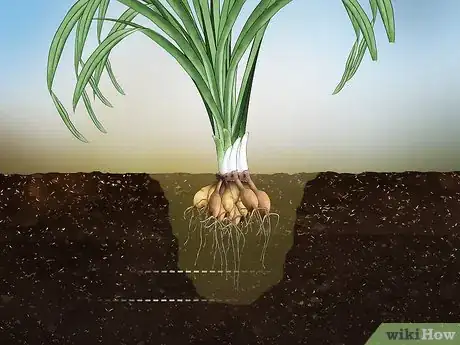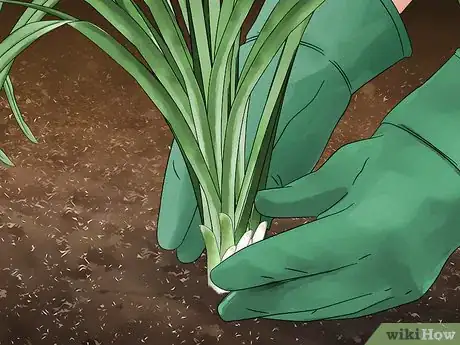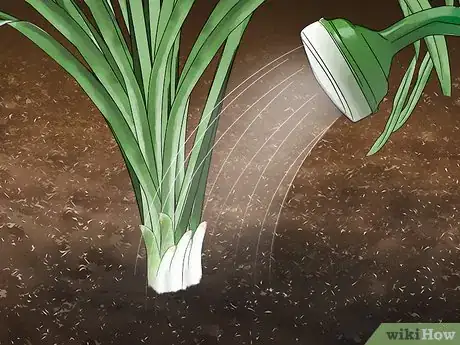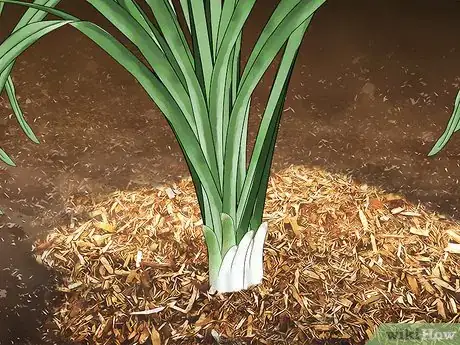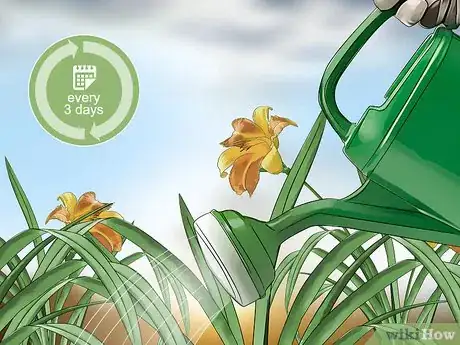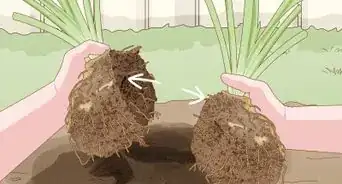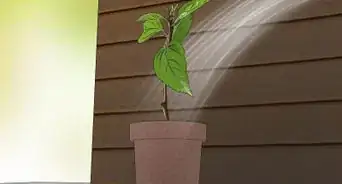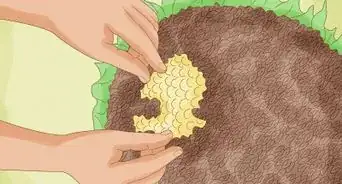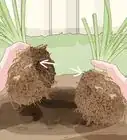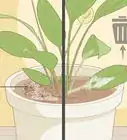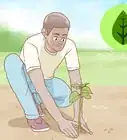This article was co-authored by Lauren Kurtz. Lauren Kurtz is a Naturalist and Horticultural Specialist. Lauren has worked for Aurora, Colorado managing the Water-Wise Garden at Aurora Municipal Center for the Water Conservation Department. She earned a BA in Environmental and Sustainability Studies from Western Michigan University in 2014.
There are 10 references cited in this article, which can be found at the bottom of the page.
wikiHow marks an article as reader-approved once it receives enough positive feedback. This article received 16 testimonials and 97% of readers who voted found it helpful, earning it our reader-approved status.
This article has been viewed 265,047 times.
Daylilies are an easy, inexpensive, and pretty perennial to grow in your garden. They can be divided into smaller clusters that you can share with friends, or use to expand your own collection. Trim the daylily leaves first before digging out the clump. Then, divide the clump into smaller groups of fans by untangling the roots. Next, replant your new divisions of daylilies, and with a bit of water and sunshine they will be flourishing in no time!
Steps
Removing and Separating the Daylilies
-
1Separate crowded daylilies in the spring. Daylilies are crowded when you can see tight clumps of leaves and stunted growth. The blooms will begin to get smaller as the plants get more crowded.[1]
- You will see new growth above the ground in early spring, which is another indicator that the daylilies are ready to be separated.
- Alternatively, you can wait until fall when the daylilies have finished blooming.
- Daylilies will usually begin to look crowded after 4 to 5 years.
-
2Trim the daylily leaves and flowers to 8 to 12 in (20 to 30 cm) high. Use garden secateurs to trim off both the leaves and flowers, leaving only 8 to 12 in (20 to 30 cm) of growth from the ground. When the leaves are shorter, you will be able to see the individual fans of leaves.[2]
- If the leaves are already shorter than 8 to 12 in (20 to 30 cm), you don’t need to trim them.
- Garden secateurs or bypass pruners are the best tool to use to trim the daylilies, as they are precise and give a clean cut.
Advertisement -
3
-
4Dig up the root ball. Use the spade to dig up the clump of daylilies. Work the soil from all sides around the clump, and dig until you reach the bottom of the roots. Then lift the clump up and out of the ground.[5]
- You can also use a garden fork for this step if you prefer.
- The roots will exceed the outline of the clump by several inches, so include as many as possible when removing the root ball.[6]
- The roots of daylilies are very resilient. Don’t worry if you end up breaking or tearing a few.
-
5Clean the soil out of the roots. Use your hands to brush loose soil out of the root ball. Then run the root ball under water from a garden hose to remove any remaining soil.[7]
- This will help to separate the roots and to remove any unwanted pests.
-
6Separate a group of 2 to 3 fans away from the clump. Use your hands to gently untangle the roots of each fan. Grasp the set of fans and carefully wiggle them away from the rest of the clump.[8]
- Daylily fans are the individual daylily plants. Each fan has leaves, roots, and a crown, which is where all of the leaves meet together at the base.[9]
- You can also separate each fan individually, however a group of 2 to 3 fans tends to look aesthetically better.
- If you have the time, leave each fan outside to air dry for 24 hours. This helps to prevent disease.[10]
Replanting Daylilies
-
1Pick a sunny spot with well-drained soil to replant the daylilies. Daylilies do best either in the sun or in partial shade. These perennials will grow in almost any type of soil, however they will grow best in more fertile soil.[11]
- To test the soil drainage, dig a hole that is 12 in (30 cm) across by 12 in (30 cm) deep. Pour enough water into the hole to fill it, and monitor the water as it drains. If the water takes over 1 hour to drain, this means that the soil has poor drainage. You can improve the soil drainage by adding organic matter to the soil, such as manure, compost, or peat moss.[12]
- Avoid planting daylilies beneath trees, as the plants will need to compete with the trees for sunlight and soil nutrients.
-
2Dig a hole slightly deeper than the roots of the daylily fans. Use a garden shovel to dig a hole in the designated spot. Form a small mound in the center of the hole that reaches to 0.5 to 1 in (1.3 to 2.5 cm) below the top of the hole, and is approximately 1 in (2.5 cm) wide.[13]
- If you are digging multiple holes to plant the groups of daylilies, leave 12 to 18 in (30 to 46 cm) of space between each hole to give the daylilies room to grow.[14]
-
3Place the group of 2 to 3 fans into the hole before backfilling the hole. Rest the crown of the fans on top of the mound of soil. Let the roots drape down around the mound. Hold the daylily fans steady as you push the soil back into the hole.[15]
- When the soil reaches the top of the hole, press lightly around it to firm the soil.[16]
-
4Water the daylilies immediately after replanting. Use a watering can or garden hose on a low pressure to lightly water the plant. A light sprinkling of water to make the soil damp will do, as this will settle the soil.[17]
-
5
-
6Water the daylilies every 3 days when the weather is dry. Add either liquid or granular fertilizer at least once per spring season to help your plants thrive. Care for the daylilies and divide them again after approximately 4 years.[20]
- At the end of spring, remove any dead or dying vegetation.
Expert Q&A
Did you know you can get expert answers for this article?
Unlock expert answers by supporting wikiHow
-
QuestionA neighbor gave me a bunch of divided daylilies a few weeks ago. They've been in a brown paper bag for a few weeks and they seem a little dry. Is it too late to plant them?
 Lauren KurtzLauren Kurtz is a Naturalist and Horticultural Specialist. Lauren has worked for Aurora, Colorado managing the Water-Wise Garden at Aurora Municipal Center for the Water Conservation Department. She earned a BA in Environmental and Sustainability Studies from Western Michigan University in 2014.
Lauren KurtzLauren Kurtz is a Naturalist and Horticultural Specialist. Lauren has worked for Aurora, Colorado managing the Water-Wise Garden at Aurora Municipal Center for the Water Conservation Department. She earned a BA in Environmental and Sustainability Studies from Western Michigan University in 2014.
Professional Gardener
-
QuestionHow far apart should daylilies be planted?
 Community Answer12 to 18 inches is recommended. You can plant them closer, but that will crowd new roots and new growth. After a few years, you can divide them and plant those in an enlarged garden or share them with friends.
Community Answer12 to 18 inches is recommended. You can plant them closer, but that will crowd new roots and new growth. After a few years, you can divide them and plant those in an enlarged garden or share them with friends. -
QuestionIs it necessary to fertilize the daylillies when dividing and replanting them? If so, what should I use?
 Community AnswerNo. If your soil has good organic material, you don't need fertilizer. Using mulch around the plant is helpful in reducing weeds, holding water in the soil, and protecting the plant through the winter.
Community AnswerNo. If your soil has good organic material, you don't need fertilizer. Using mulch around the plant is helpful in reducing weeds, holding water in the soil, and protecting the plant through the winter.
Things You’ll Need
- Daylilies
- Gardening gloves
- Garden secateurs
- Garden spade
- Garden fork
- Hose
- Mulch
- Fertilizer
References
- ↑ https://www.thisoldhouse.com/how-to/how-to-divide-daylilies
- ↑ https://garden.org/ideas/view/Char/1544/Dividing-Daylilies-Overcoming-the-Fear-of-Separation/
- ↑ https://www.thisoldhouse.com/how-to/how-to-divide-daylilies
- ↑ https://garden.org/ideas/view/Char/1544/Dividing-Daylilies-Overcoming-the-Fear-of-Separation/
- ↑ https://garden.org/ideas/view/Char/1544/Dividing-Daylilies-Overcoming-the-Fear-of-Separation/
- ↑ https://www.thisoldhouse.com/how-to/how-to-divide-daylilies
- ↑ https://garden.org/ideas/view/Char/1544/Dividing-Daylilies-Overcoming-the-Fear-of-Separation/
- ↑ https://garden.org/ideas/view/Char/1544/Dividing-Daylilies-Overcoming-the-Fear-of-Separation/
- ↑ https://www.daylilies.org/ahs_dictionary/fan.html
- ↑ https://garden.org/ideas/view/chalyse/1423/Potted-Daylilies-Trimming-Roots/
- ↑ https://daylilies.org/daylilies/faq/
- ↑ https://www.bhg.com/gardening/yard/soil/what-is-well-drained-soil/
- ↑ https://garden.org/ideas/view/Char/1544/Dividing-Daylilies-Overcoming-the-Fear-of-Separation/
- ↑ https://www.gardeners.com/how-to/growing-daylilies/8104.html
- ↑ https://garden.org/ideas/view/Char/1544/Dividing-Daylilies-Overcoming-the-Fear-of-Separation/
- ↑ https://garden.org/ideas/view/Char/1544/Dividing-Daylilies-Overcoming-the-Fear-of-Separation/
- ↑ https://garden.org/ideas/view/Char/1544/Dividing-Daylilies-Overcoming-the-Fear-of-Separation/
- ↑ https://www.southernliving.com/home-garden/gardens/dazzling-daylilies
- ↑ https://www.bhg.com/gardening/flowers/perennials/how-to-divide-daylilies/
- ↑ https://www.daylilygarden.com/daylily-questions/general-questions-about-daylily-care-and-culture-2017.html
- ↑ https://daylilies.org/daylilies/faq/
About This Article
To divide daylilies, wait until early spring when you see new growth above the ground, or wait until fall when your daylilies have finished blooming. To get started, loosen the ground around a clump of daylilies with a spade. Next, use the spade to dig up the root ball, digging up as many of the roots as possible. Then, use your hands to loosen the soil in the root ball and use a garden hose to wash it away. Finally, separate a group of 2-3 fans away from the clump and replant them in your garden. To learn how to replant daylilies after dividing them, scroll down!
